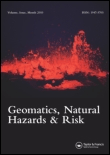
Geomatics Natural Hazards & Risk
Scope & Guideline
Championing Open Access Research in Earth Sciences
Introduction
Aims and Scopes
- Geospatial Analysis of Natural Hazards:
The journal emphasizes the use of geospatial technologies, such as remote sensing and GIS, to analyze and model natural hazards like landslides, floods, and earthquakes. This focus allows for a deeper understanding of spatial patterns and risk assessments. - Risk Assessment and Management:
Research published in the journal often includes methodologies for assessing risks associated with natural hazards. This includes vulnerability assessments, risk mapping, and the evaluation of disaster management strategies. - Integration of Machine Learning Techniques:
A consistent theme in recent publications is the integration of machine learning algorithms to enhance predictive modeling and decision-making in the context of natural hazards and risk assessment. - Climate Change Impacts on Natural Hazards:
The journal addresses the implications of climate change on the frequency and severity of natural hazards, exploring how changing environmental conditions influence disaster risk and mitigation strategies. - Multi-Hazard Approaches:
There is a notable focus on multi-hazard assessments, where researchers investigate the interconnections between different types of hazards and their cumulative impacts on communities and ecosystems.
Trending and Emerging
- Advanced Remote Sensing Applications:
There is a growing trend in utilizing advanced remote sensing technologies, including satellite imagery and UAVs, for real-time monitoring and assessment of natural hazards. This reflects a shift towards more accurate and timely data collection. - Data-Driven Decision-Making:
The integration of big data analytics and machine learning for predictive modeling and decision-making is on the rise. Researchers are increasingly focusing on how to leverage large datasets to improve hazard forecasting and risk management. - Community Resilience and Adaptation Strategies:
Emerging studies emphasize the importance of community resilience in the face of natural disasters. Research is focusing on adaptive capacity-building strategies that empower communities to better prepare for and respond to hazards. - Interdisciplinary Approaches:
The journal is witnessing a trend towards interdisciplinary research that combines insights from geology, meteorology, urban planning, and social sciences to provide comprehensive assessments of natural hazards. - Climate Change Adaptation and Mitigation:
As concerns over climate change intensify, there is an increasing focus on research that addresses adaptation strategies for mitigating the impacts of climate change on natural hazards, emphasizing sustainability and long-term planning.
Declining or Waning
- Traditional Statistical Methods:
The reliance on traditional statistical methods for hazard assessment appears to be waning as newer machine learning approaches gain popularity. Researchers are increasingly favoring advanced algorithms that can handle complex datasets more efficiently. - Generalized Natural Hazard Studies:
There is a noticeable decrease in studies that address natural hazards in a generalized manner without specific focus on particular events or regions. The trend is moving towards more localized and case-specific research. - Static Risk Assessment Models:
Static models that do not account for dynamic changes in environmental conditions or human factors are becoming less common. Researchers are gravitating towards adaptive models that incorporate real-time data and feedback mechanisms.
Similar Journals
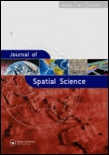
Journal of Spatial Science
Advancing Interdisciplinary Insights in Spatial ScienceThe Journal of Spatial Science, published by Taylor & Francis Ltd, serves as a prominent platform for the dissemination of research in the interdisciplinary fields of geography, atmospheric science, and energy. With an ISSN of 1449-8596 and an E-ISSN of 1836-5655, this journal has established itself as a vital resource since its inception in 2004, boasting an impressive convergence period extending to 2024. Recognized in the Q3 quartile for Atmospheric Science and Energy (miscellaneous), and achieving a Q2 classification in Geography, Planning and Development in 2023, the journal not only reflects the evolving complexities of spatial science but also underscores its increasing relevance in addressing contemporary global challenges. The journal holds a commendable position in Scopus rankings, with notable placements in various categories, further highlighting its academic significance. Researchers, professionals, and students are encouraged to engage with the rich content offered, as the Journal of Spatial Science remains committed to advancing knowledge and fostering discussions pertinent to spatial analysis and its applications.

International Journal of Engineering and Geosciences
Exploring the synergy between technology and the Earth.The International Journal of Engineering and Geosciences, with ISSN 2548-0960, is a premier academic journal published by Selcuk University Press, specializing in the interrelated fields of engineering and geosciences. Established as an Open Access resource in 2016, the journal aims to enhance the dissemination of research, fostering collaboration and innovation within the scientific community. Based in Turkey, this journal serves as a vital platform for researchers and professionals to share their findings and contribute to the advancement of knowledge in environmental science and related disciplines. With an impressive Q2 category ranking in the field of Environmental Science (miscellaneous) for 2023, it ranks #81 out of 219 in Scopus, placing it in the 63rd percentile. The journal not only acknowledges transformative research trends from 2019 to 2024 but also emphasizes the importance of sustainability and environmental stewardship in engineering practices, making it an indispensable resource for students, researchers, and professionals passionate about the intersection of these disciplines.

NATURAL HAZARDS
Driving research to mitigate the impacts of natural disasters.NATURAL HAZARDS is a premier academic journal published by SPRINGER that focuses on the multidimensional aspects of natural hazards, their impacts, and mitigation strategies. With a robust impact factor and esteemed rankings in reputable databases such as Scopus, this journal is classified in the Q2 category in Atmospheric Science and Q1 in both Earth and Planetary Sciences (miscellaneous) and Water Science and Technology, showcasing its influence in these critical fields. Established in 1988 and continuing through 2024, it serves as a vital resource for researchers, professionals, and students alike, providing cutting-edge research and insights into the dynamics of natural hazards. Although it does not offer open-access options, the journal is accessible through institutional subscriptions, ensuring that high-quality research is disseminated efficiently to those dedicated to advancing our understanding of environmental challenges. By publishing empirical studies, theoretical analyses, and case studies, NATURAL HAZARDS plays a crucial role in informing disaster management policies and strategies, thereby contributing to a safer, more resilient world.
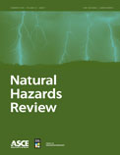
Natural Hazards Review
Building Knowledge for a Resilient WorldNatural Hazards Review, published by the ASCE-Amerc Soc Civil Engineers, is a prominent journal dedicated to advancing the understanding of the impacts of natural hazards on civil infrastructure, the environment, and societal dynamics. With a focus on interdisciplinary approaches, this journal plays a vital role in the fields of Civil and Structural Engineering, Environmental Science, and Social Sciences, evidenced by its Q2 rankings across multiple categories in 2023. Throughout its publication history since 2000, the journal has emerged as a key resource for researchers, practitioners, and students, providing innovative insights and fostering critical discussions regarding disaster risk reduction, resilience strategies, and sustainable practices. Although it does not currently offer open access options, authors and readers alike can benefit from its robust contributions as it continues to shape the discourse on mitigating the effects of natural hazards. By disseminating high-quality research, Natural Hazards Review is instrumental in promoting a comprehensive understanding of this pressing global issue.

Bulletin of Geography-Physical Geography Series
Exploring the dynamics of our planet's landscapes.The Bulletin of Geography-Physical Geography Series is a prominent open-access journal dedicated to advancing the field of physical geography. Published by Nicolaus Copernicus University in Poland, this journal has been a vital resource for researchers, professionals, and students alike since its inception in 2009. With an ISSN of 2080-7686 and an E-ISSN of 2300-8490, it contributes significantly to the academic discourse in geography, planning and development, and geophysics, boasting a 2023 Scopus rank of #385 in Social Sciences and #84 in Earth and Planetary Sciences. The journal aims to disseminate innovative research and critical insights that address contemporary challenges in physical geography, making it a valuable platform for those seeking to contribute to or stay informed about the latest developments in the field. With its commitment to quality and accessibility, the Bulletin of Geography-Physical Geography Series plays a crucial role in fostering scholarly exchange and collaboration globally.
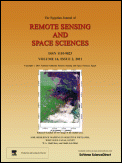
Egyptian Journal of Remote Sensing and Space Sciences
Advancing Knowledge in Remote Sensing and Space SciencesThe Egyptian Journal of Remote Sensing and Space Sciences, published by Elsevier, is a premier open-access journal dedicated to advancing the fields of Remote Sensing and Space Sciences. Since its inception, the journal has gained a prominent reputation, currently holding a prestigious Q1 ranking in Earth and Planetary Sciences and placing within the top 10% of its field according to Scopus metrics. With an ISSN of 1110-9823 and an E-ISSN of 2090-2476, the journal features a diverse range of scholarly articles that explore both theoretical and practical aspects of remote sensing technologies and space science innovations, thus appealing to researchers, professionals, and students alike. Established in 2003 and fully transitioning to an open-access model in 2010, the journal aims to disseminate knowledge and foster collaboration across the globe by providing wider accessibility to groundbreaking research findings. Its commitment to quality and innovation is a catalyst for intellectual development in these dynamic and evolving disciplines.
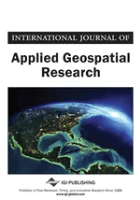
International Journal of Applied Geospatial Research
Empowering multidisciplinary contributions in geospatial research.International Journal of Applied Geospatial Research is an esteemed publication dedicated to advancing the field of geospatial research. Published by IGI Global, this journal provides a platform for innovative studies from 2010 to 2024 that encourage multidisciplinary contributions across Earth and planetary sciences and geography. While currently not offering open access, the journal's focus on applied research ensures that it remains highly relevant to both academics and industry professionals alike. With an ISSN of 1947-9654 and an E-ISSN of 1947-9662, it has been indexed in various databases, reflecting its emerging significance with rankings such as Q4 in Earth and Planetary Sciences and Geography according to Scopus, placing it at the intersection of critical research and practical application. Researchers, professionals, and students can expect insightful articles that enhance understanding and drive innovation in geospatial applications essential for informed decision-making in a rapidly changing world.
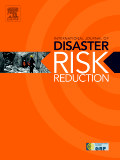
International Journal of Disaster Risk Reduction
Advancing resilience through innovative disaster risk strategies.The International Journal of Disaster Risk Reduction is a leading academic publication dedicated to advancing the understanding and management of disaster risks, promoting innovative solutions and effective strategies for risk reduction. Published by ELSEVIER, this journal serves as a critical platform for researchers, professionals, and students in the fields of Geology, Geotechnical Engineering, and Safety Research. With an impressive impact factor and ranked in the top quartile (Q1) across its various categories as of 2023, it demonstrates exceptional quality and relevance in its contributions to science and engineering disciplines. The journal has been committed to disseminating high-quality research since its inception in 2012 and remains open for new submissions through 2024. The Scopus rankings reflect its prestigious position, with notable placements in Earth and Planetary Sciences and Social Sciences, highlighting its influence in shaping best practices for disaster risk governance. As an essential resource for anyone involved in disaster preparedness and mitigation, the International Journal of Disaster Risk Reduction fosters knowledge exchange and collaboration among stakeholders in the global community.
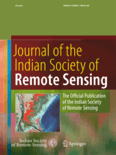
Journal of the Indian Society of Remote Sensing
Exploring Innovations in Remote Sensing ApplicationsJournal of the Indian Society of Remote Sensing, published by SPRINGER, stands as a prominent contribution to the fields of Earth and Planetary Sciences and Geography, Planning and Development. With an ISSN of 0255-660X and an E-ISSN of 0974-3006, this esteemed journal has been in circulation since 1973, showcasing a rich repository of research and advancements in remote sensing applications, methodologies, and technologies, specifically within the Indian context and beyond. The journal's impact is underscored by its placement in the Q2 category of both Earth and Planetary Sciences and Geography as of 2023, ranking impressively in the Scopus database with significant percentiles. With the intent to bridge the gap between theory and practical application, it invites scholars, researchers, and professionals to contribute innovative studies that enhance our understanding of remote sensing and its implications in various domains. The Journal of the Indian Society of Remote Sensing is a vital resource for anyone looking to remain at the forefront of research in this dynamic field.

International Journal of Applied Earth Observation and Geoinformation
Navigating the Future of Geoinformation and Sustainability.International Journal of Applied Earth Observation and Geoinformation is a premier peer-reviewed journal published by Elsevier, focusing on the integration and application of earth observation and geoinformation technologies across diverse fields. With an open access model established in 2020, this journal enhances accessibility and dissemination of research crucial for addressing global challenges related to climate change, resource management, and sustainable development. The journal occupies a notable position within the academic community, featuring a Q1 ranking in multiple categories including Computers in Earth Sciences, Earth-Surface Processes, and Global and Planetary Change, reflecting its significant impact and relevance in these disciplines. It is recognized for its high-quality articles that explore innovative methodologies and applications, making it an essential resource for researchers, practitioners, and students alike who seek to advance their understanding of earth dynamics and geospatial technology. The journal is indexed in Scopus with impressive rankings that underscore its high citation impact and scholarly influence, with an emphasis on providing a platform for the latest findings in management, monitoring, and policy in environmental science.